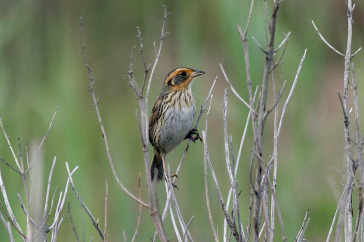The University of New Hampshire inspires innovation and transforms lives in our state, nation and world. More than 16,000 students from all 50 states and 71 countries engage with an award-winning faculty in top-ranked programs in business, engineering, law, health and human services, liberal arts and the sciences across more than 200 programs of study. A Carnegie Classification R1 institution, UNH partners with NASA, NOAA, NSF and NIH, and received $260 million in competitive external funding in FY21 to further explore and define the frontiers of land, sea and space.
UNH, UMaine Establish Genomic Ecology of Coastal Organisms Program

The Saltmarsh Sparrow. (Credit: Dominic Sherony)
DURHAM, N.H.—The University of New Hampshire, in collaboration with the University of Maine, has established a new research and training program to prepare graduate and undergraduate students in the region on the ecological genomics of coastal organisms. Funds for the project are provide by an NSF EPSCoR grant.
The program is fundamental for understanding links between genomes and phenomes in natural populations, or, more specifically, how genetic underpinnings shape the traits that enable tidal marsh birds to adapt and evolve in response to environmental change. It also aims to advance STEM education by training scientists in an interdisciplinary research approach that transcends biological scales, from the molecular to the ecological.
The program is led by Adrienne Kovach, assistant professor of natural resources and the environment at UNH as well as a researcher with the NH Agricultural Experiment Station, and Brian Olsen at UMaine. The collaboration brings together researchers from across northern New England and leverages previous research conducted by Kovach and her collaborators.
“Tidal marshes are natural laboratories for studying the links between genomes, phenomes, and fitness of birds in the wild,” said Kovach. “This project will help us better understand the genome-phenome relationship beyond knowledge gained in the lab, where the critical ecological links to the expression and fitness of tidal marsh birds within a complex, natural ecosystem are not feasible to replicate.”
While the genome is the complete set of genetic material present in an organism, the phenome is the set of observable characteristics ranging from physical appearance and behavior to disease resistance and susceptibility. These characteristics are determined by both genetic makeup and environmental factors, as well as the interaction between genetic makeup and environment. Recent advances in genome sequencing technologies have opened new avenues for studying the factors and features that produce particular phenotypes in individuals and populations of organisms.
“These are key questions in evolutionary biology today, which can only be pursued through studies like this one of wild populations in dynamic, natural environments,” she said. “The project will advance understanding of long-standing questions in evolutionary biology as well as provide new insight into genetic elements and mechanisms that underlie the resilience and adaptive capacity of tidal marsh birds. The latter are important for predicting the ability of tidal marsh birds to respond to rapidly changing environments.”
The scientific knowledge generated by this research will aid with biodiversity conservation in an ecosystem strongly influenced by human populations. It will be directly relevant to tidal marsh birds, which are threatened with extinction by sea-level rise and a high priority for state, federal, and international conservation organizations. Scientists will share their research results with state, federal and nongovernmental organizations that focus on translating conservation research into on-the-ground actions.
This material is based upon work supported by NSF EPSCoR Track 2 under award number 1826777. This research leverages previous funding from the NH Agricultural Experiment Station, through joint funding of the National Institute of Food and Agriculture, U.S. Department of Agriculture, under award number 1016574, and the state of New Hampshire.
Founded in 1887, the NH Agricultural Experiment Station at the UNH College of Life Sciences and Agriculture is UNH’s original research center and an elemental component of New Hampshire's land-grant university heritage and mission.
NH EPSCoR works to advance New Hampshire's competitiveness in science and engineering by strategically investing in research infrastructure, promoting education in the STEM disciplines, and fostering partnerships with technology-based businesses that enhance job creation and economic development.
PICTURE AVAILABLE FOR DOWNLOAD
https://colsa.unh.edu/nhaes/sites/default/files/media/images/saltmarshsparrow.jpg
The Saltmarsh Sparrow. (Credit: Dominic Sherony)
-
Media Contact
Lori Tyler Gula, PhD | NH Agricultural Experiment Station | lori.gula@unh.edu | 603-862-1452
Latest News
-
June 18, 2024
-
June 18, 2024
-
May 17, 2024
-
May 14, 2024
-
May 7, 2024

















































